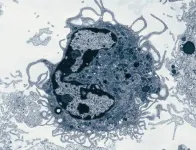(Press-News.org) COLUMBUS, Ohio – The rising earth beneath the Antarctic Ice Sheet will likely become a major factor in future sea level rise, a new study suggests.
Despite feeling like a stationary mass, most solid ground is undergoing a process of deformation, sinking and rising in response to many environmental factors. In Antarctica, melting glacial ice means less weight on the bedrock below, allowing it to rise. How the rising earth interacts with the overlying ice sheet to affect sea level rise is not well-studied, said Terry Wilson, co-author of the study and a senior research scientist at the Byrd Polar and Climate Research Center at The Ohio State University.
In the new study, Wilson’s colleagues at McGill University developed a model to predict how these interactions could impact global sea level, finding that if humans can lower greenhouse gas emissions and global warming is slowed, upward shifts in the solid earth could reduce Antarctica’s contribution to sea level rise by about 40%, significantly bolstering the best case scenarios for global sea level rise. In this low-emissions scenario, land uplift slows the flow of ice from land to ocean, allowing for more of the ice sheet to be preserved.
Conversely, if humans are unable to lower carbon emissions in time, ice retreat will outpace uplift, pushing ocean water away from Antarctica and amplifying sea level rise. These events could significantly worsen the most dire models of projected sea level rise along populated coastlines, said Wilson.
“Our measurements show that the solid earth that forms the base of the Antarctic ice sheet is changing shape surprisingly quickly,“ said Wilson. “The land uplift from reduced ice on the surface is happening in decades, rather than over thousands of years.”
The study was published today in Science Advances.
To arrive at these conclusions, the team developed a 3D model of the Earth’s interior using geophysical field measurements from the Antarctic Network (ANET) of the Polar Earth Observing Network (POLENET) project. The mission is focused on studying the changing polar regions by collecting GPS and seismic data from an array of autonomous systems across Antarctica.
Researchers then performed a number of simulations to capture many possible evolutions of Antarctica’s ice sheet and the extent of global sea level rise Earth may experience until the year 2500, according to those parameters.
“We can project what difference it actually will make if we all contribute to a low-emission scenario now, versus what’s come to be called ‘business as usual’ emissions,” said Wilson, who is also the lead investigator of the ANET-POLENET project.
She attributes the model’s unprecedented level of detail to how deftly it incorporates data from Antarctica. GPS stations monitor how the land is moving and seismometers measure how fast seismic waves from earthquakes travel through the earth, yielding important insight into where the land uplift will be fast or slow.
Surprisingly, according to some of the team’s GPS observations processed by researchers at Ohio State, Wilson said, the Antarctic Ice Sheet is currently experiencing a solid earth uplift of about 5 centimeters per year, about 5 times the rate that North America experiences.
Another significant aspect of the study is how the changes in Antarctica under different carbon emissions scenarios will impact coastlines around the world. Because sea level change will not be uniform, the study notes that nearly 700 million people around the world living in coastal regions will be most impacted by rising seas due to Antarctic ice loss.
Since some regions, such as small island nations, will be more vulnerable than others, mitigating environmental conditions like atmospheric and ocean warming is a vital issue for society, said Wilson.
“Many people are now more aware they’re experiencing the effects of climate change,” she said. “This work reinforces that our actions as individuals, nations and globally can make a difference in what kind of Earth our offspring will experience in their lifetimes.”
The study results highlight how complex the relationship between the solid earth and the processes that happen atop it is, as well as the importance of continuing to gather enough data to make prompt and accurate predictions about what the next few centuries of our planet will look like.
“There’s a lot of uncertainty in every model and every prediction that you make,” said Wilson. “But to document how fast our world is changing, it’s very important to continue advancing our ability to make predictions that are more certain, which is the only path that will allow us to tend to our future in a meaningful way.”
Wilson completed the study with colleagues from McGill University, Pennsylvania State University, the University of Massachusetts Amherst, Columbia University, Washington University, Colorado State University and the Union of Concerned Scientists. This study was supported by the U.S National Science Foundation and the Natural Sciences and Engineering Research Council of Canada.
#
Contact: Terry Wilson, Wilson.43@osu.edu
Written by: Tatyana Woodall, Woodall.52@osu.ed
END
How the rising earth in Antarctica will impact future sea level rise
Effects will depend on how much global warming is controlled, study finds
2024-08-02
ELSE PRESS RELEASES FROM THIS DATE:
Research spotlight: Uncovering the links between sleep struggles, substance abuse and suicidal thoughts in teens with depression
2024-08-02
Rebecca Robbins, PhD, of the Division of Sleep and Circadian Disorders at Brigham and Women’s Hospital, is the senior author of a paper published in Psychiatry Research, “Exploring sleep difficulties, alcohol, illicit drugs, and suicidal ideation among adolescents with a history of depression.”
How would you summarize your study for a lay audience?
Suicide is one of the leading causes of death for adolescents in the U.S. We know, due to previous research, that difficulty falling asleep or waking up too early as well as abuse of prescription ...
Boosting children’s voices could help to relieve significant backlogs in the family court, study says
2024-08-02
Giving children a right to be heard and taken seriously when parents separate could help couples reach sustainable child arrangements and relieve significant backlogs in the family court, avoiding unnecessary financial and emotional costs, a new study says.
Mediation, court and legal processes should provide a forum for young people’s views on post-separation arrangements being considered for them to be aired independently and factored in wherever appropriate. Giving them more agency about decisions which affect their lives and futures will help families make more effective ...
Study yields new insights into the link between global warming and rising sea levels
2024-08-02
A McGill-led study suggests that Earth's natural forces could substantially reduce Antarctica’s impact on rising sea levels, but only if carbon emissions are swiftly reduced in the coming decades. By the same token, if emissions continue on the current trajectory, Antarctic ice loss could lead to more future sea level rise than previously thought.
The finding is significant because the Antarctic Ice Sheet is the largest ice mass on Earth, and the biggest uncertainty in predicting future sea levels is how this ice will respond to climate change.
“With nearly 700 million people living in coastal areas and the potential ...
Controlling thickness in fruit fly hearts reveals new pathway for heart disease
2024-08-02
Scientists at Sanford Burnham Prebys and Salk Institute for Biological Studies have uncovered a new role for a protein known for its role in the brain helping control feelings of hunger or satiety, as well as in the liver to aid the body in maintaining a balance of energy during fasting. The new study shows that this protein also supports the maintenance of heart structure and function, but when it is overactive it causes thickening of the heart muscle, which is associated with heart disease.
Excessive thickening of the heart muscle—known as cardiac hypertrophy—is often ...
Improving cat food flavors with the help of feline taste-testers
2024-08-02
Cats are notoriously picky eaters. But what if we could design their foods around flavors that they’re scientifically proven to enjoy? Researchers publishing in ACS’ Journal of Agricultural and Food Chemistry used a panel of feline taste-testers to identify favored flavor compounds in a series of chicken-liver-based sprays. The cats particularly enjoyed the sprays that contained more free amino acids, which gave their kibble more savory and fatty flavors.
Cats have a more acute sense of smell than humans, and the aroma of their food plays a big role in whether they’ll eat or snub what their owner serves for dinner. Feline palates are also more sensitive to umami ...
Subclinical hypothyroidism in early pregnancy associated with more than quadrupled risk of reduced thyroid function within 5 years of delivery
2024-08-02
A new study has shown that subclinical hypothyroidism diagnosed before 21 weeks of pregnancy is associated with more than fourfold higher rates of overt hypothyroidism or thyroid replacement therapy within 5 years of delivery. The study is published in the peer-reviewed journal Thyroid®, the official journal of the American Thyroid Association® (ATA®).
Subclinical hypothyroidism, or a change in the levels of thyroid-stimulating hormone (TSH) that isn’t severe enough to cause symptoms, ...
BNP-Track algorithm offers a clearer picture of biomolecules in motion
2024-08-02
It’s about to get easier to catch and analyze a high-quality image of fast-moving molecules. Assistant Professor Ioannis Sgouralis, Department of Mathematics, and colleagues have developed an algorithm that adds a new level to microscopy: super-resolution in motion.
The cutting-edge advancement of super-resolution microscopy was recognized with the 2014 Nobel Prize in Chemistry for its groundbreaking innovation. It improves optical microscopy with a suite of techniques that overcome the inherent limitations set by the physics of light. The high-frequency oscillations of light waves escape detection ...
Not the day after tomorrow: Why we can't predict the timing of climate tipping points
2024-08-02
A new study published in Science Advances reveals that uncertainties are currently too large to accurately predict exact tipping times for critical Earth system components like the Atlantic Meridional Overturning Circulation (AMOC), polar ice sheets, or tropical rainforests. These tipping events, which might unfold in response to human-caused global warming, are characterized by rapid, irreversible climate changes with potentially catastrophic consequences. However, as the new study shows, predicting when these events will occur is more difficult than previously thought.
Climate scientists from the Technical University of Munich (TUM) and ...
Discovery of a new population of macrophages promoting lung repair after viral infections
2024-08-02
Researchers at the University of Liège (Belgium) have discovered a new population of macrophages, important innate immune cells that populate the lungs after injury caused by respiratory viruses. These macrophages are instrumental in repairing the pulmonary alveoli. This groundbreaking discovery promises to revolutionize our understanding of the post-infectious immune response and opens the door to new regenerative therapies.
Respiratory viruses, typically causing mild illness, can have more serious consequences, as shown during the Covid-19 pandemic, including severe cases requiring hospitalization and the chronic sequelae of "long Covid." These conditions ...
Scientists pin down the origins of the moon’s tenuous atmosphere
2024-08-02
While the moon lacks any breathable air, it does host a barely-there atmosphere. Since the 1980s, astronomers have observed a very thin layer of atoms bouncing over the moon’s surface. This delicate atmosphere — technically known as an “exosphere” — is likely a product of some kind of space weathering. But exactly what those processes might be has been difficult to pin down with any certainty.
Now, scientists at MIT and the University of Chicago say they have identified the main process that formed the moon’s atmosphere and continues to sustain ...
LAST 30 PRESS RELEASES:
Scientists to ‘spy’ on cancer- immune cell interactions using quantum technology breakthrough
Tech savvy users have most digital concerns
Making lighter work of calculating fluid and heat flow
Normalizing blood sugar can halve heart attack risk
Lowering blood sugar cuts heart attack risk in people with prediabetes
Study links genetic variants to risk of blinding eye disease in premature infants
Non-opioid ‘pain sponge’ therapy halts cartilage degeneration and relieves chronic pain
AI can pick up cultural values by mimicking how kids learn
China’s ecological redlines offer fast track to 30 x 30 global conservation goal
Invisible indoor threats: emerging household contaminants and their growing risks to human health
Adding antibody treatment to chemo boosts outcomes for children with rare cancer
Germline pathogenic variants among women without a history of breast cancer
Tanning beds triple melanoma risk, potentially causing broad DNA damage
Unique bond identified as key to viral infection speed
Indoor tanning makes youthful skin much older on a genetic level
Mouse model sheds new light on the causes and potential solutions to human GI problems linked to muscular dystrophy
The Journal of Nuclear Medicine ahead-of-print tip sheet: December 12, 2025
Smarter tools for peering into the microscopic world
Applications open for funding to conduct research in the Kinsey Institute archives
Global measure underestimates the severity of food insecurity
Child survivors of critical illness are missing out on timely follow up care
Risk-based vs annual breast cancer screening / the WISDOM randomized clinical trial
University of Toronto launches Electric Vehicle Innovation Ontario to accelerate advanced EV technologies and build Canada’s innovation advantage
Early relapse predicts poor outcomes in aggressive blood cancer
American College of Lifestyle Medicine applauds two CMS models aligned with lifestyle medicine practice and reimbursement
Clinical trial finds cannabis use not a barrier to quitting nicotine vaping
Supplemental nutrition assistance program policies and food insecurity
Switching immune cells to “night mode” could limit damage after a heart attack, study suggests
URI-based Global RIghts Project report spotlights continued troubling trends in worldwide inhumane treatment
Neutrophils are less aggressive at night, explaining why nighttime heart attacks cause less damage than daytime events
[Press-News.org] How the rising earth in Antarctica will impact future sea level riseEffects will depend on how much global warming is controlled, study finds



